Burnout in UX is real — and it’s often caused by the environment, not just the workload. It’s not only about working too hard; it’s about working in the wrong conditions for too long. Tight deadlines, shifting priorities, messy feedback loops, and having no real say in decisions — it all adds up. Over time, it wears you down. Not just creatively, but emotionally.
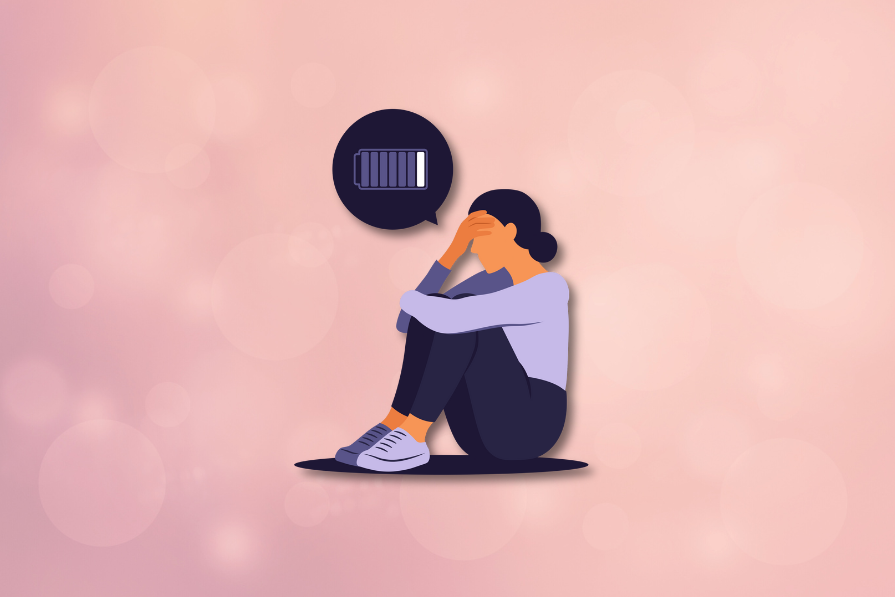
You might still be shipping designs and joining meetings, but something feels off. You start to feel disconnected from your work, drained of energy, and unsure of your motivation. You may even begin to question your own abilities.
Now, I’m no therapist — I’m a designer.
But I can tell you this. Burnout isn’t a sign of weakness. It’s often a natural response to a chaotic or unsupportive work environment. And I’ve seen it firsthand — not just in myself, but in other talented designers who slowly lost their spark under the weight of poor processes, unclear roles, and unrealistic expectations.
In this article, I’ll explore the real causes of burnout in UX — especially the ones no one talks about. From team-level issues to broader systemic problems, I’ll break down the warning signs and share ways to spot burnout early, protect your energy, and bounce back if you’re already deep in it.
Burnout isn’t solved with a meditation app or team pizza. It usually stems from deeper issues in how teams operate and the culture they create. Here are some common patterns that slowly wear UX designers down:
Ever been in a review where everyone has an opinion and no one agrees? One person says, “Make the logo bigger.” Another says, “Make it smaller.”
Feedback is essential to design — but when it’s endless, unstructured, and coming from all directions, it becomes draining instead of helpful.
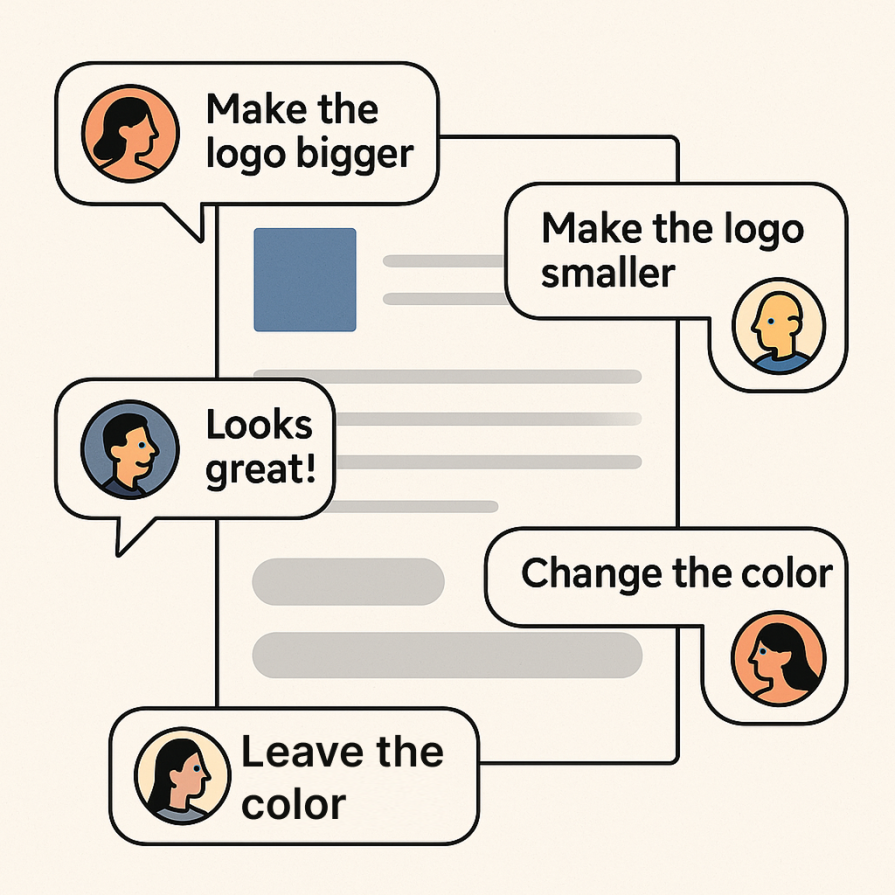
Why it burns us out:
There’s no clear owner or direction. Designers get stuck trying to please everyone, and the original vision gets lost. The constant back-and-forth is mentally exhausting.
What helps:
I’ve spent weeks designing things that never shipped — all because priorities suddenly changed, or someone higher up made a last-minute call. Has this happened to you? It’s not just frustrating. It’s demoralizing.
Why it burns us out:
It’s not the workload — it’s the wasted work. When priorities shift without warning, and UX is looped in too late, designers lose control over the outcome. You start thinking, “Why bother?” That mindset leads straight to burnout.
What helps:
In one of my past roles, I was hired as a “UX designer” — and then expected to do UI design, front-end QA, project management, and on one memorable occasion, an office party flyer. Many UXers can relate to wearing too many hats.

When teams are structured poorly, designers end up doing a bit of everything. If other roles are missing or not empowered, UX tries to fill the void. The result? Overwork and identity crisis.
Why it burns us out:
When you’re doing two or three jobs at once, burnout becomes inevitable. You can’t excel at all of them, so you constantly feel like you’re behind or failing.
Role confusion also leads to duplicated effort and tension. Maybe you’re taking on PM tasks while your PM micromanages design — everyone steps on each other’s toes. It’s exhausting and usually leads to long hours to cover all bases.
What helps:
Raise your hand if you’ve had to constantly explain what UX is to your organization (my hands are raised). In low-maturity teams, designers are often treated as pixel polishers instead of problem solvers. You’re brought in late, expected to “make it pretty,” and left out of strategy discussions, and you spend more time defending your role than doing the actual work.
Why it burns us out:
You’re fighting for permission to do your job. It’s draining to keep explaining the value of UX or justifying every research request. When leadership doesn’t “get” UX, your voice carries less weight, and that repeated uphill battle leaves you again demoralized and exhausted.
What helps:
Designing without research is like flying blind, and yet, it’s often the norm. Teams talk about “user-centric” processes, but when deadlines hit, research is the first thing cut. Designers end up guessing, hoping their intuition aligns with actual user needs.
Why it burns us out:
When research isn’t prioritized, every decision feels risky. You second-guess yourself, overwork to compensate, or worse, feel like your skills don’t matter. It also fuels imposter syndrome; you can’t defend your choices without evidence, and everything becomes a guessing game.
What helps:
Sometimes designers are brought in to make products look good without knowing what “good” looks like. You’re told to “10x the product” or “just make it better,” but never given a clear target. You work harder, second-guess yourself constantly, and still feel like you’re falling short.
Why it burns us out:
Ambiguity creates anxiety. Without clear expectations, designers default to perfectionism or over-delivery, which leads to long hours and mental strain. On the flip side, unrealistic goals set you up to fail, and repeated failure, even if it’s not your fault, wears you down fast.
What helps:
Burnout is real — but not inevitable. By making changes at the team and organizational level, we can create an environment where designers thrive instead of flaming out.
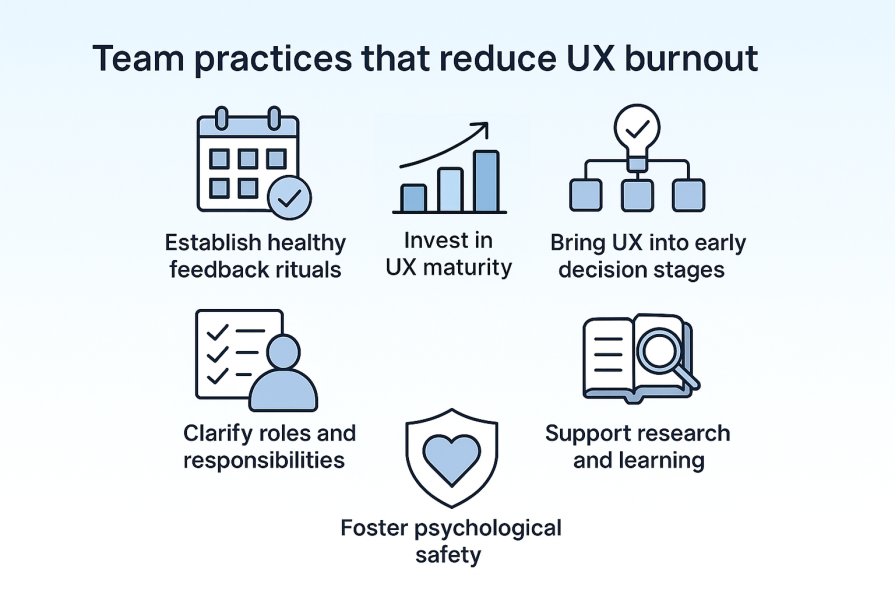
Here are some practical, team-level solutions I’ve seen make a real difference:
Establish healthy feedback rituals
Make feedback a scheduled, focused activity rather than a constant drip. For example, implement weekly design critiques with clear rules: all feedback must be constructive and tied to user or business goals, and decisions made during the critique are final for that cycle. This prevents the never-ending feedback loop and builds trust in the process.
Bonus: Encourage a culture of appreciation alongside critique, call out what’s working, not just what’s not. It keeps morale higher.
Bring UX into early decision stages
Advocate for a UX seat at the table when defining product strategy or feature roadmaps. If designers (or UX researchers) are involved from the start, decisions will be user-centered from day one, and there will be far fewer “surprise reworks” later.
Teams can formalize this — like making UX review a required step before closing any product requirement. It leads to better outcomes and gives designers more agency, which can eventually reduce burnout.
Clarify roles and responsibilities
If your team frequently asks, “Who’s doing what?” That’s an issue, and it’s time to map it out. Try making a RACI chart (Responsible, Accountable, Consulted, Informed) for common tasks.
And don’t overload a single person with multiple full-time roles. If you have a “unicorn” doing UX, UI, research, and content strategy, recognize that’s unsustainable long-term.
Either adjust expectations (maybe 60% UX, 20% research, 20% visual design, explicitly) or lobby to distribute those tasks (e.g., hire a part-time researcher or use agency help). Clarity here prevents the burnout that comes from overextension and role confusion.
Invest in UX maturity
Leaders, this one’s on you. If designers are burning out because they’re constantly justifying their existence, you have a UX maturity problem. Work to educate and empower the whole org around UX. This could mean sending product folks to a UX workshop, sharing case studies of UX-driven success, or hiring a UX manager or architect who can champion the cause at higher levels.
Even small moves help, for instance, include UX goals in your quarterly objectives (e.g., “Conduct 3 user tests this quarter” or “Improve usability of checkout flow as measured by X”). When the company starts measuring and rewarding UX work, it signals that UX is a valued part of the process, not a disposable nice-to-have. Over time, raising UX maturity builds a safety net for designers — they feel supported, not isolated, defending good design.
Support research and learning
Champion a research-friendly culture. Allocate a portion of the design budget or sprint capacity explicitly to research and discovery. Even if you’re lean, empower designers to spend, say, 10% of their time talking to users or keeping up with UX best practices. If you can, hire a UX researcher (even part-time or contract) to lighten the load on designers for user studies.
Foster psychological safety
All the process fixes in the world won’t help if people don’t feel safe to speak up. Teams should cultivate an atmosphere where designers (and everyone) can call out issues without fear. If a deadline is unrealistic, the designer should feel comfortable saying so. When someone shows signs of burnout, they need support, not judgment
Each of these steps requires effort and commitment, but I’ve seen their impact. When my team started doing proper design critiques and involving UX early in projects, the whole vibe changed. Designers felt heard and less like last-minute pixel jockeys.
This article would not be complete without a personal note on recovery. Yes, systemic fixes are the long-term solution, but what do you do when you are facing it?
Here are a few things that helped me reclaim my sanity and passion that you can learn from:
Burnout, as brutal as it is, taught me a valuable lesson: we can’t separate the quality of our work from the quality of our work environment. You can be a passionate and resilient designer, yet still burn out if the system around you is flawed. As UX professionals, we’re trained to spot problems and design better solutions — it’s time we apply those skills to our own workplaces. That means acknowledging the systemic issues (like the ones above) and having the courage to address them head-on.
If you’re a design leader or manager, listen to your team: are they quietly withdrawing, churning out work with less enthusiasm, maybe dropping hints of frustration? Don’t dismiss that. Take it seriously and take action. Sometimes, relatively small changes can transform a team’s morale and energy. Remember, burnout hurts both the designer and the design.
If you’re going through burnout, know that it’s okay to pause. It’s okay to reach out for help. And please remember, it’s not just on you to fix it. Yes, there are coping strategies (some I shared above), but we also need to push for systemic change. Share articles like this with your team, spark conversations, and give feedback upward. Good organizations will listen and learn (and if yours doesn’t… keep your portfolio ready and know that better cultures exist out there).
The best design happens when people are supported, not just squeezed. Let’s design better teams, not just better products.
LogRocket's Galileo AI watches sessions and understands user feedback for you, automating the most time-intensive parts of your job and giving you more time to focus on great design.
See how design choices, interactions, and issues affect your users — get a demo of LogRocket today.

Discover how to craft UX-friendly hero sections with examples, design tips, and strategies that drive engagement and conversion.
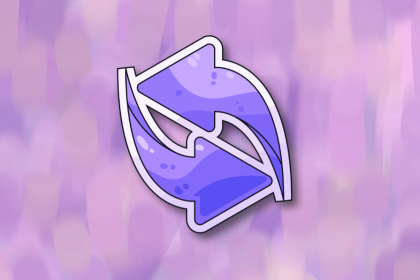
I once sent a half-written email by accident, until Gmail saved me with an Undo button. Those tiny moments define trust in UX. In this guide, we’ll break down how to design reversible actions, when to use them, and how to choose the right recovery pattern for your product.
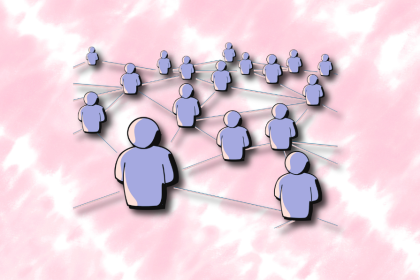
Small qualitative samples aren’t a weakness. They’re a strategy. This guide breaks down the evidence, the mindset gap, and how to build trust around research decisions.

From pixel art to neon palettes, retro design is resurging across marketing, gaming, fashion, and indie web. Learn how nostalgia, brand differentiation, and anti-minimalism fatigue are shaping modern UX and how to balance style with usability.